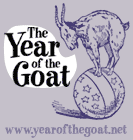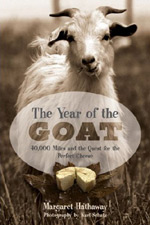Goat Days has the feel of a county fair, which, aside from the caprine focus, is pretty much what it is. There were Boy Scouts and local charity fund raisers, and a tent of Baptists giving out cold bottles of "Living Water" inscribed with Bible verses. After setting up our tent, we wandered around the booths and pens, getting our bearings and talking to some families from the Tennessee Dairy Goat Association (TDGA). One of the women was struggling to get her kid, a goat that must have been just a few months old, into a child's cow costume. While we talked to her, she put the costume on three goats in succession, embarrassing one little Nubian so much that she lay down and hung her cow-covered head. Finally, she strapped the costume to a larger Nubian, securing it with string rather than squeezing the goat into the body of the costume. She'd just finished tying the last hoof when the kickoff parade was announced. The parade was casual, and included goats and children in costume, Shriners dressed as hillbilly clowns, and the trolley that brought people in from the parking lot. It lasted about five minutes, after which the festivities officially commenced.
At seven, a crowd gathered around a pen near the stage and the Best Dressed Goat contest was held. One by one, goats were led into the ring, each dressed in a costume, though with varying degrees of elaboration. There was an angel, a clown, a horse, a purple dinosaur, a World War II fighter pilot, and the cow, complete with a sign that said Got Milk! I'm not sure if there's anything cuter than small animals in costumes being led by small children in costumes; Karl must have used an entire role of film during the fifteen minute contest. After much deliberation, the judges announced Li'l Bit, in the dinosaur costume, as third place winner, Emmett, the horse, as second, and Charlie Brown, the fighter pilot, as first. The women who showed Li'l Bit and Charlie Brown scooped them up like babies and went off to find some dinner, while Emmett, who was scheduled to pull a chariot the next day, had his picture taken with toddlers sitting in his saddle.
Karl and I went in search of barbecue and ended up at the "Bad Pigs" barbecue pit, run by the Millington Police Department. Their booth was marked by a cutout of a pig wearing sunglasses, and was crowned by three flashing blue lights. They were competing in the barbecue and the cabrito challenge the following day (and would go on to win with their Goat Wellington), but on Friday night they were simply raising funds for the department and enjoying the festival. For a minimal donation, we gorged ourselves on police ribs, pulled pork, and delicious spicy beans, and listened to them discuss the evening's barbecue shortcomings. One officer, in a resigned and serious voice, kept shrugging his shoulders and repeating, "I put 'em on too late, and I'm cookin' 'em slow."
After our pigout, we poked around the booths a little, but were really too tired to do much more than buy our souvenir t-shirts and tote bags. As exhausted as we were, on the way back to our tent we were sidetracked by the Boer goat pens, where farmers and 4-H kids were washing their goats for the morning competitions. It was a flurry of shampooing and hoof trimming, udder clipping and horn oiling, all punctuated by plaintive bleating. Even while they were tidying their goats, nearly everyone we spoke with was more than happy to answer our questions, often in more detail than we even understood. It was really encouraging to talk with goat farmers, but it also cast our ignorance into sharp relief. We have a lot to learn about goats, specifically, but also livestock farming in general. Becky Sweet, the owner, with her husband Roger, of Sweetheart Farms in Arkansas, told us that she still studies up on goats for two or three hours a night. This night, however, there was no studying for us. We were lucky to stagger, yawning, back to our tent, where we unstuffed our sleeping bags and passed out at eight-thirty. — MMH


